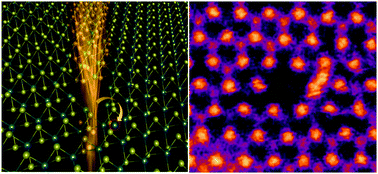Atomic structure and formation mechanism of sub-nanometer pores in 2D monolayer MoS2†
Abstract
We use electron-beam nanofabrication to create sub-nanometer (sub-nm) pores in 2D monolayer MoS2 with fine control over the pore size down to 0.6 nm, corresponding to the loss of a single Mo atom and surrounding S atoms. The sub-nm pores are created in situ with 1 nm spatial precision in the MoS2 lattice by control of the angstrom sized probe in an aberration corrected scanning transmission electron microscope with real time tracking of the pore creation. Dynamics of the sub-nm pore creation are captured at the atomic scale and reveal the mechanism of nanopore formation at accelerating voltages of 60 and 80 kV to be due to displacing a Mo atom from the lattice site onto the surface of the MoS2. This process is enabled by the destabilization of the Mo bonding from localized electron beam induced S atom loss. DFT calculations confirm the energetic advantage of having the ejected Mo atom attach on the sheet surface rather than being expelled into vacuum, and indicate sensitivity of the nanopore potential as a function of the adsorption position of the ejected Mo atom. These results provide detailed atomic level insights into the initial process of single Mo loss that underpins the nucleation of a nanopore and explains the formation mechanism of sub-nm pores in MoS2.



 Please wait while we load your content...
Please wait while we load your content...